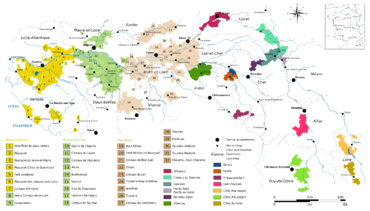Côtes d'Auvergne
Although more than 40 kilometers from the Loire, the Côtes d'Auvergne wine-growing region is part of the large Loire wine-growing region . The 'Cotes d'Auvergne' lie on the historic landscape of the Auvergne south of the appellation Saint-Pourçain and west of the appellations Cotes du Forez and Côte Roannaise .
location
The wine-growing region is located near the town of Clermont-Ferrand , mostly on the volcanic slopes on the left bank of the Allier River in central France. The cultivation areas are at an altitude of 380-530 meters above sea level. d. M. and are spread around the city of Clermont-Ferrand.
history
The bishop Sidonius Apollinaris (approx. 430–490) already reported in the 5th century on wine growing in the Auvergne. At the end of the 18th century, viticulture was practiced in the region on about 21,000 hectares; after the French Revolution it was even 34,000 hectares. In the middle of the 19th century it was the third largest growing area in France (after the Aude and Hérault regions). Stocks were, however, by the phylloxera ( Phylloxera decimated); In addition, the wine was considered to be of less and less quality as the area under cultivation increased. Since 1948, the Compagnons du Bousset d'Auvergne ( bousset = portable keg) has been striving for a consistent quality policy and marketing of the wine-growing region. The appellation 'Côtes d'Auvergne' was classified as VDQS on March 14, 1977 .
size
The vineyards currently cover around 1,000 hectares of vineyards in 53 municipalities. Around 460 hectares are professionally managed. There are 5 sub-regions within the wine-growing region

- Côtes d'Auvergne Madargue (12 ha)
- Côtes d'Auvergne Châteaugay (64 ha)
- Côtes d'Auvergne Chanturgue (6 ha)
- Côtes d'Auvergne Corent (32 ha)
- Côtes d'Auvergne Boudes (45 ha)
About 50 winemakers market their products themselves. The other 130 winemakers work for the region's cooperative winery. Approximately 410 hectares of vineyards do not meet the requirements of the appellation and are owned by families who still produce for their own use.
Wines
- The dry red wines are a blend of the grape varieties Gamay vinified and Pinot Noir. The harvest restriction is 45 hectoliters / hectare. The minimum alcohol content is a low 9 percent by volume and must not exceed 12.5% in the case of chaptalization . The ruby red, fruity wines should be drunk within 4–6 years after harvest. The drinking temperature should be 15–17 ° C.
- The rosé wines are mostly made from single varieties from Gamay and are predominantly made dry. Their optimal drinking temperature is 10 ° C. The Rosé de Corent from the Côtes-d'Auvergne Corent sub-region enjoys a particularly good reputation.
- The dry white wines , which make up barely 10% of production, are made from a single variety of Chardonnay . The wines should be drunk within 3–5 years after harvest. The drinking temperature should be 11–13 ° C.
The quality of the 2003 and 2005 vintages is considered exceptional.
Approved municipalities
- In the Arrondissement of Clermont-Ferrand : Aubière , Authezat , Beaumont , Billom , Chanontat , Chas , Chauriat , Cébezat , Clermont-Ferrand , Corent , Cournon d'Auvergne , Le Crest , Dallet , Laps , Lempdes , Les Martres-de-Veyre , Mezel , Mirefleurs , Orcet , Pérignat-lès-Sarliève , Pignols , Plauzat , La Roche-Banche , La Roche-Noire , Romagnat , Saint-Amant-Tallende , Saint-Bonnet-lès-Allier , Saint-Georges-lès-Allier , Saint -Maurice-lès-Allier , Saint-Saindoux , La Sauvetat , Sayat , Tallende , Vertaizon and Vic-le-Comte
- In the arrondissement of Riom : Beauregard-Vendon , Châteaugay , Châtel-Guyon , Gimeaux , Malauzat , Ménétrol , Prompsat , Riom , Saint-Hippolyte , Volvic and Yssac-la-Tourette
- In the Arrondissement of Issoire : Boudes , Neschers , Saint-Hérent , Sauvagnat-Sainte-Marthe and Saint-Yvoine
literature
- Pierre Galet: Cépages et Vignobles de France . Lavoisier Publishing House, Paris 2004, ISBN 2-7430-0585-8 .
- Benoît France: Grand Atlas des Vignobles de France . Éditions SOLAR publishing house, Paris 2002, ISBN 2-263-03242-8 .
Web links
- Wines of the Côtes d'Auvergne (French)
- Wines of the Cotes d'Auvergne (Engl.)
